#California Grape Growing Valley
Explore tagged Tumblr posts
Text
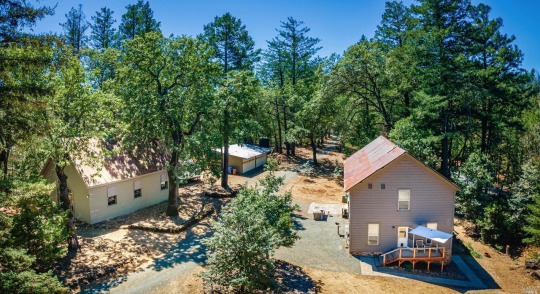

So, yesterday, we saw a huge modern, all-white estate vineyard in Napa, California. Today we have another Napa Valley vineyard in Helena, California, but this one is very different. Actually, the other one was kind of boring, and this one is unique. The carriage house dates back to the 1880s. The main house has 3bds, 2.5ba, and costs a lot less at $3.25M. (The other one is $22M.)
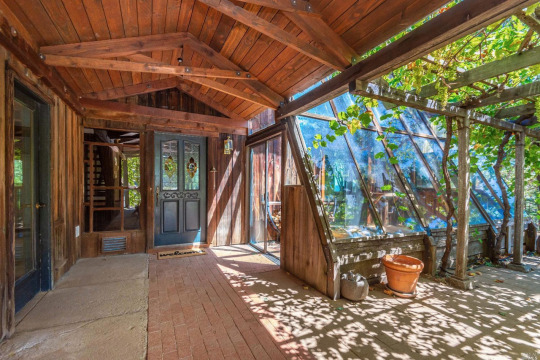
Isn't this nice? A sunroom and pergola with vines.

Clearly, this is a rustic style home with a high vaulted living room ceiling, and a stained glass window.

There's a lofted space above the living room, which is very nice as well.

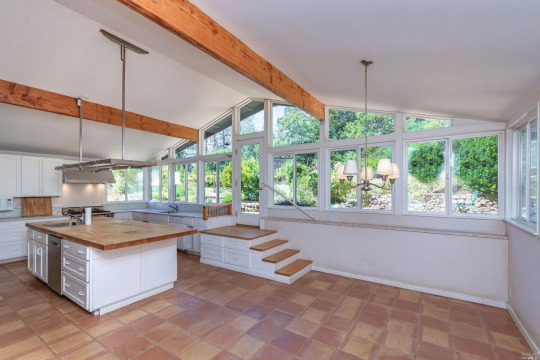
The large kitchen is light and airy.

This looks like a workroom or office and it has a great fireplace that looks like it was well-used.

Looks like a family room.

The primary bedroom is a good size.
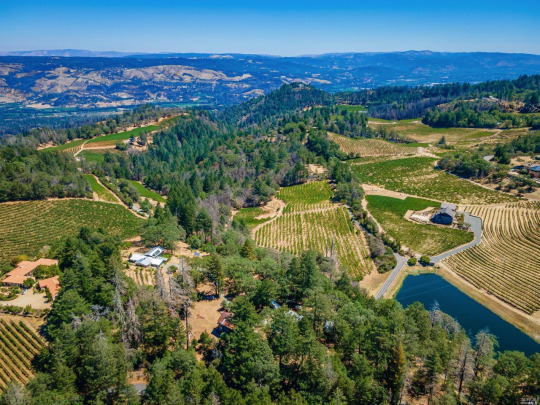
There are about 4.59 acres of property with the vineyard.

But, where the other property was just vineyards, this is where this property gets interesting, b/c it ain't just grapes.


Check it out- it has a cave, b/c this property was also a winery. The cave is protected by heavy wooden doors and iron gates.
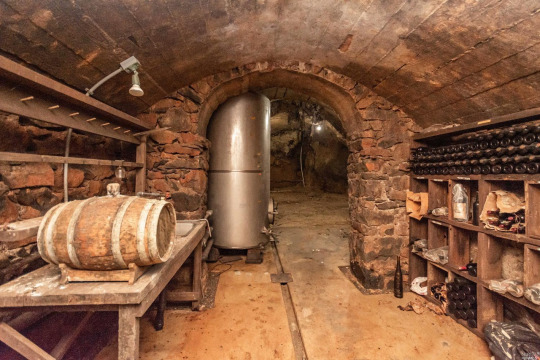
This was a serious winery. Look at the bottles and supplies, plus the fermenting equipment.

This is cool.

The fermenting tanks look in pretty good shape.
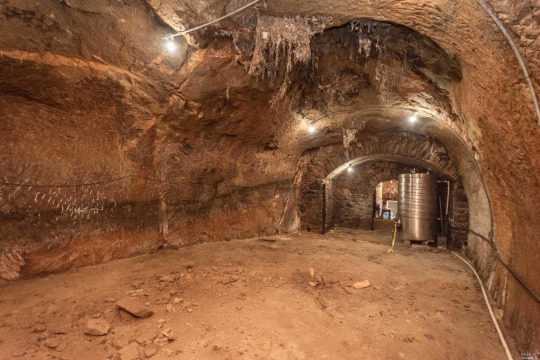
Remember that this cave dates back to the 1880s. It's ancient.
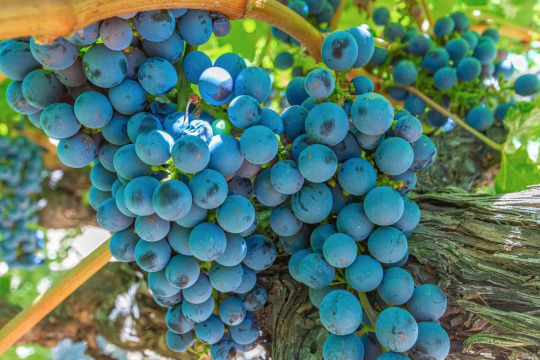
Look at these delicious grapes. Every fall I wait for the stores to have Concord grapes b/c my grandparents had a huge grapevine and they were so good.
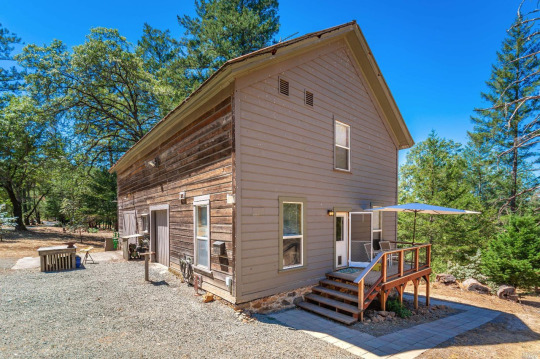
There's a barn on the property, but it looks like there's an apt. above it.

Workshop in the barn.
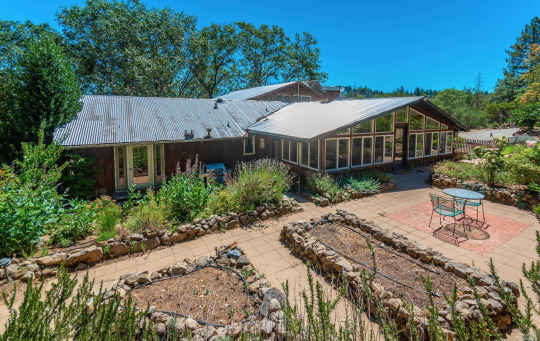
The main house has a large patio with growing beds.
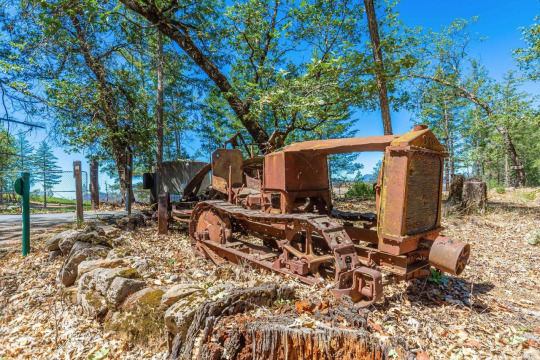
I'm thinking that this rusted old tractor is art?
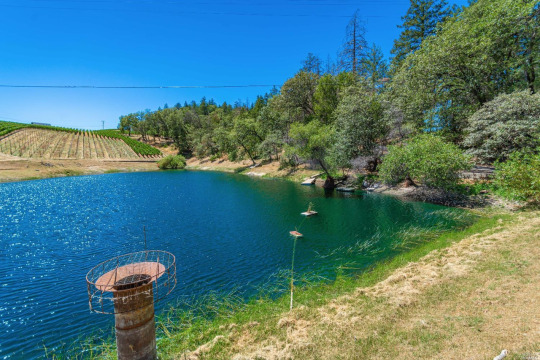
Looks like a pond. Maybe for crop irrigation.

The house, on the bottom right, is surrounded by many neighboring vineyards.
80 notes
·
View notes
Video
youtube
Happy Mothers Day to all the moms and the positive women in my life. Mi madre loves CCR, and growing up in the Central Valley, this song often comes up.
One story I’ve been told by a handful of old dogs was CCR was supposed to play in Lodi Grape Festival. But once the organizers were shocked to see the band is a bunch of long-haired, bluesy, rockers, the gig got cancelled, and CCR spent the rest of the day hanging around a hotel. I’ve never seen anywhere else if that story is real. The other story is about CCR hypothetically becoming has-beens, spending the rest of their mortal days doing small gigs in backwards towns they could never leave. The latter feel more plausible.
Submitted by @eggs-n-ham-sam
I enjoyed this performance, Fogerty getting the family together to jam that’s good times for everyone.
I went and looked up the story behind the song,
The song describes the plight of a down-and-out musician whose career has landed him playing gigs in the town of Lodi, California. After playing in local bars, the narrator finds himself stranded and unable to raise bus or train fare to leave.
Fogerty later said he had never actually visited Lodi before writing the song, and simply picked it for the song because it had "the coolest sounding name." The song's chorus, "Oh Lord, stuck in Lodi again," has been the theme of several city events in Lodi.
So the one you like best is closest to the truth there.
I love Fogerty though, leader of one of the best southern rock acts (and solo artists) ever was born and raised in the Bay Area of CA, wild thing to have happen.
Kinda like how Mike Patton of, well too many acts to list, is from Eureka CA, not a place known for his brand of music, well the ones he got famous initially with at least.
Guy can do anything really.
2 notes
·
View notes
Text
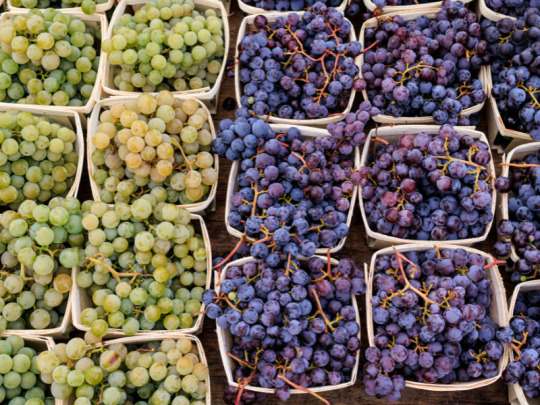
We have grape news as September is prime grape season in our farmers markets! Not only is New York state famous for its apples (we are the Big Apple, of course), it also produces the third largest volume of grapes in the United States, behind only California and Washington state.
New York has a long history of grape cultivation that began in the 17th century when Dutch and Huguenot settlers planted grapes in the Hudson Valley. These colonists initially attempted to grow French and European vines that they brought with them across the Atlantic. However, the foreign vines quickly succumbed to pests, diseases and the harsh winters. Instead, the settlers cultivated native grapes that had been part of the native American diet for over 10,000 years.
The Hudson Valley went on to become an important table grape producer and the birthplace of American wine. In 1827, Richard Underhill established the first commercial winery in the region, making wine from native grapes. From 1920-1933, Prohibition illegalized the manufacture, transportation, and sale of alcohol and many New York wineries were forced to close. Those that survived switched to growing grapes for non-alcoholic uses, such as raisins, jam, and grape juice.
Today, New York state is known for its famous wine regions and its tasty table grapes. While the uniformly sweet and simple flavor of supermarket grapes is designed for mass appeal, farmers market grapes boast complex flavor profiles with depth and dimension. Here are several locally grown grape varieties that you can easily find being sold at our fruit stalls this month.
Catawba Grape The Catawba grape originated on the East Coast, somewhere between the Carolinas and Maryland. This pinkish, purplish grape is thought to be a cross between the native North American species Vitis labrusca (also known as fox grape) with the European species Vitis vinifera. It was first cultivated in the early 19th century by German settlers in the Catawba River valley of North Carolina.
The Catawba grape was widely grown in central New York in the mid-1800s. It became wildly popular for its use in sparkling wines and rosés, gaining recognition as one of the first distinctively American wine grapes. Today, it is still highly regarded for its unique flavor profile and continues to be celebrated as an important part of American winemaking history. The grape has a pronounced "foxiness", which refers to the earthy and musky aromas commonly associated with Vitis labrusca grape varieties. When eaten fresh, Catawba grapes are seedy, firm and juicy with a sweet and spicy flavor.
Niagara Grape The North American Niagara grape is a variety of Vitis labrusca. The grape was developed in 1868 by Claudius L. Hoag and Benjamin W. Clark in Niagara County, New York through a cross of Concord grapes and white Cassady grapes. It is used as a table grape and for making wine, jams and juice. Niagara is the leading green grape grown in the United States.
Niagara grapes are poor shipping grapes, so are usually found being sold near to where they are grown in New York, Pennsylvania, New Jersey, Michigan, Washington and Ohio. While rarely available fresh outside these areas, Niagara grapes are well-known as the source of most of the white grape juice consumed by Americans.
The fresh Niagara grape is large and juicy, round to oval-shaped with a pale greenish-white color. The grape’s sweetly pleasant “foxy” aromas have been likened to that of candied lemon rind, Riesling, flowery jasmine, and high-toned, sugary muskiness.
Concord Grape The Concord grape is named after the town in Massachusetts where it was developed. Another Vitis labrusca cultivar, the Concord grape is the most well-known foxy grape and is considered to be the quintessential American grape. Concord grapes are prized as table grapes and juice grapes. They also are used to make grape jelly, grape pies, grape-flavored soft drinks, and candy. The fruit is sometimes used to make wine, particularly sacramental and kosher wine. Thanks to its popularity, the grape is now cultivated in many parts of the world.
The skin of a Concord grape is typically dark blue or purple and often is covered with a glaucous epicuticular wax "bloom" that can be rubbed off. It is a slip-skin variety, meaning the skin is easily separated from the fruit. Concord grapes are richly flavorful, musky and sweet. They have large seeds that are safe to eat and contain healthful nutrients, flavonoids and fiber. If you prefer not to eat the seeds, you can chew the whole grape, then use your teeth and tongue to sieve out the seeds.
We hope that all this juicy grapevine gossip has made your mouth water! There are plenty more New York state grape varieties to be discovered before the weather turns and grape season is over until next year. So be sure to head to your Down to Earth farmers market this weekend to pick up lush bunches of these delectably tasty, locally grown fruits.
#downtoearthmkts#farmersmarket#farmersmarkets#eatlocal#shoplocal#buylocal#localfood#eatdowntoearth#local food#concord grapes#niagara grapes#catawba grapes#grapes#grape season
0 notes
Text
Enjoying Napa Valley, California: The Most Complete Wine Tour Adventure
Napa Valley in California is an excellent getaway for both informal and wine-loving tourists since it is known for its great wine and luxurious experiences. A wine tour of Napa Valley, which is recognized for its stunning scenery, top-notch wineries, and extensive viticultural traditions, provides an unmatched experience into the core of one of the most renowned wine areas internationally. A guided wine tour of Napa Valley promises to be an amazing experience that will deepen your appreciation for the region's natural beauty and the craft of winemaking, regardless of your level of experience.

An Exploration of Napa's Beautiful Beauty
The extensive wineries and rolling landscape of the Napa Valley region offer a breathtaking sight that sets the mood for the wine tour. With the beautiful Mayacamas and Vaca mountain ranges framing the scene, you'll be treated to expansive vistas of the valley's luscious grapevines. The seasons' shifting hues give an additional touch of beauty, with vivid autumn tones and blooming springtime providing a lovely setting for your wine-tasting excursion. Traveling through Napa Valley is a sensory experience that appeals to the eyes and the taste, and it is not just about enjoying the wine. It is also about taking in the beautiful scenery.
Exploring Famous Wineries
Visiting to see some of the most well-known wineries in the area is a highlight of any wine tour in the Napa Valley. Every winery in Napa Valley has a unique feel and personality that reflects the variety of winemaking styles and traditions that the region is known for. You can experience a variety of wine-making ideas and practices at these estates, which range from tiny, family-owned wineries to expensive, traditional ones.
Winemakers and talented guides will take you through exclusive tastings of some of Napa's best wines at each location. You'll taste a range of wines, such as wines made from Pinot Noir, the white wine Chard Cabernet Sauvignon, and Merlot, and discover the unique qualities that set each one apart. The wine tastings offer an enhanced comprehension of the artistry and enthusiasm that are invested in each bottle, regardless of whether you're savoring a traditional Napa Valley red wine or exploring a new favorite variety.
Entertaining Wine-Tasting Moments
Wine tours in Napa Valley are meant to give you more than just a taste of the wines; they are meant to immerse you in the winemaking process. Access to the production regions behind closed doors is a feature of many tours, allowing you to witness the exquisite attention to detail that goes into the fermentation, aging, and harvests of grapes. You could even get to talk to winemakers and grape-growing owners to learn more about their backgrounds and the particular difficulties they face in their line of work.
Several journeys also include guided winery walks, where you may tour the wineries and discover more about the many grape varietals and producing environments that go into creating the region's wide range of wines. These educational elements give your wine-tasting experience more depth and enable you to appreciate each wine's characteristics with a deeper comprehension of its history.
Wine and Delicious Food Pairing
A visit to the Napa Valley wine country would not be complete without sampling some of the best food the area has to offer. Gourmet meals cooked by famous chefs and made using materials that come from the area and perfectly match the wines are served during many tours. The dining options, which range from sophisticated sit-down meals to laid-back picnics in the vineyards, are designed to bring out the flavors of the wines and give guests an honest understanding of Napa Valley's farm-to-table concept.
Identifying the best pairings for various wine styles is made easier with the expert guidance offered during these meals. Wine and food pairing is an art in and of itself. The pairing of good wine and gourmet cuisine takes the tasting experience to new heights, whether you're enjoying a heavy, fleshy stew with a full-bodied red or a fresh seafood dish with a refreshing California Sauvignon Blanc.
Reaching Past the Wine
When wine is the main attraction, Napa Valley has a variety of activities to do in addition to your wine-tasting experience. A lot of trips include breaks at the valley's beautiful cities and towns, where you may explore the boutiques, galleries, and historic sites. Napa and the neighboring towns provide more than just wineries; they are renowned for their booming arts scene and cultural attractions.
Nature lovers are also encouraged to experience hiking trails, hot air balloon flights, and beautiful drives by the natural splendor of Napa Valley. For example, a hot air balloon flight provides an amazing view of the valley's breathtaking landscape and wineries, increasing your awareness of the area's natural beauty.

In summary
A Napa Valley wine tour explores the rich history, varied flavors, and breathtaking vistas that characterize this famous place. It is more than just a trip through one of the world's best wine areas. Every element of the journey, from the breathtaking vineyard scenery to the rich wine-tasting experiences and fine dining, has been designed to leave you with lasting emotions and strengthen your bond with the craft of winemaking. A Napa Valley wine tour is a fantastic way to take in everything that California's wine country has to offer, whether you're a wine expert or just looking for a fun vacation.
#napa wine valley tours#wine tours in the napa valley#touring napa valley#wine tours of napa valley#napa wine tours
0 notes
Text























National Red Wine Day
Pour a lovely glass of Bordeaux, take a sip of a Cabernet Sauvignon or open a bottle of Shiraz because it’s time for National Red Wine Day!
History of National Red Wine Day
National Red Wine Day is an ideal time to take a look at the past of the red wine industry and see how it developed into modern times.
Wine’s history goes back several thousand years. It is estimated that Chinese people in the Henana province may have been the first ones to create something like red wine, perhaps around 7000 BC. This would have been a drink that was made of wild grapes as well as honey and rice as well as hawthorn fruit. The concoction was stored in clay jars with yeast on the skins causing it to be fermented.
The history of wine continues through the centuries. A recent discovery in 2007 in Armenia dates the first winery in the world at around 6100 BC. This earliest, prehistoric form of wine production took place in a cave was discovered by archaeologists from Armenia as well as Ireland.
Since ancient times, red wine has been part of many cultures throughout the world. As civilization has developed, so has the technology for growing the right grapes and turning it into this delicious beverage. Through the old world and the new world, red wine has come to be more than simply a drink, but it also symbolizes transformation, happiness and friendship, as well as sustenance and life.
National Red Wine Day symbolizes all of these and more. It was founded in 2014 by Jace Shoemaker-Galloway with the idea of celebrating the beauty of magnificence that is red wine. As the grapes begin to ripen and autumn begins to loom large, National Red Wine Day offers a time to enjoy and celebrate.
National Red Wine Day Timeline
6000 BC Red Wine is made in South Caucasus
People in Georgia discover that red wine can be made by burying grape juice underground during the winter.
3100 Ancient Egyptians make wine
Early versions of red wine are made from red grapes in ancient Egypt, coming along with superstitions about red wine as it resembles blood.
71 AD Bordeaux Wines are first recorded
Pliny the Elder makes the first written recorded evidence of vineyards in Bordeaux, which is in modern-day France.
1619 French grape cultivation begins in Virginia
Bringing their grapevines from France, the French cultivate their grapes in Virginia.
2014 National Red Wine Day begins
Founded by Jace Shoemaker-Galloway, the first Red Wine Day is celebrated on August 28 of this year.
How to Celebrate National Red Wine Day
Enjoying and celebrating National Red Wine Day is really no trouble at all! Don’t forget to share the experience with family and friends. Try out some of these ideas to make the most of National Red Wine Day:
Drink a Glass of Red Wine
If this isn’t the perfect day to enjoy a glass of red wine, then what is?! Whether opening up a bottle of Merlot to enjoy at home with dinner, or going out to order a glass of Cabernet Sauvignon, National Red Wine Day offers a special opportunity to pay honor to this alcoholic beverage that is both ancient and modern.
Head Out to a Wine Tasting or Vineyard (or Both!)
National Red Wine Day is the ideal time to schedule a trip to wine country to enjoy a tour or a wine tasting. A visit to a vineyard would be amazing, whether it is Texas Hill Country, Arizona’s Valle Verde or Northern & Central Virginia where grapes for America’s first red wines were originally grown. Of course, California produces about 80% of the wine in the United States, so Sonoma County, Napa Valley, Santa Barbara County and Edna Valley might make the visit to a vineyard even more accessible.
Learn More About Red Wine
Use National Red Wine Day to celebrate and take advantage of opportunities to learn more about this unique beverage. A nice way to start might be to learn a bit about the different kinds of red wine. Take a look at these varieties and try one out in honor of the day:
Merlot
Cabernet Sauvignon
Malbec
Pinot Noir
The second most planted grape in the world, Merlot is an easy wine to drink. It’s rather fruity and has a wide range of flavors, from black berries and black cherries to plums and cocoa, from herbs and graphite to vanilla and cedar. It’s a versatile wine that is great for beginners to enjoy and experience. Merlot is a red wine that is lovely to drink while eating poultry such as chicken or duck.
This is the most planted grape on the planet and it is easy to see why it is so beloved. Cabernet is a fairly safe wine that is easy to share at a table because almost everyone will enjoy it. It might have a fruity taste, with French versions showing as a bit more herby. Cabernet Sauvignon is a red wine that is great when paired with meats.
While the grapes for Malbec wine were originally grown in France, most of this variety that is produced today comes from Argentina. With its deep purple color and fruity flavors of plum and cherry, many people enjoy the ending flavors that offer a hint of smoke. Malbec is a red wine that goes well when paired with lean meats as well as with spicy foods like Indian or Mexican.
This delicate red wine offers a lighter body that is less shocking and pushy. It has a silky feel in the mouth and often has a bright berry taste, similar to raspberries or cranberries. Pinot Noir is a red wine that, surprisingly, is delicious when paired with fish, like salmon dishes or sushi.
Make a Playlist of “Red Wine” Songs
Try out some of these red wine themed songs to create a playlist in honor of National Red Wine Day:
Red, Red Wine by UB40 (1983). This classic eighties classic song is typically remembered for its funky sound, but it’s actually a cover from a Neil Diamond Song from 1967.
Melva’s Wine by Johnny Cash (1972) A country music song by musical legend Johnny Cash, Melva’s Wine is a song remembering the batch of wine made by a woman from the singer’s past.
Old Red Wine by The Who (2004). Written by Pete Townsend in memory of John Entwistle who had been a bass player for the band. Entwistle, who died in 2002 just before this song was written, was a lover of red wine.
Cherry Red Wine by Luther Allison (1995). A blues bass guitarist, Luther Allison plays and sing this song that is mostly a blend of his super fantastic guitar riffs and some minimal lyrics.
National Red Wine Day FAQs
Is red wine good for you?
Drinking an occasional glass of red wine might be healthy, with antioxidants that protect against heart disease and inflammation.
How many calories in a glass of red wine?
A 100 gram glass of red wine contains approximately 85 grams.
Can red wine go bad?
An unopened bottle of red wine can last 2-3 years past the expiration date printed on the bottle.
Does red wine need to be refrigerated after opening?
Yes! Refrigerating red wine slows down the chemical processes that make wine spoil.
Is red wine keto?
People on a keto diet can drink a very dry red wine in moderation on their keto diet.
Source
#National Red Wine Day#Beringer Vineyards#Kelleher Family Vineyard#St. Francis Winery & Vineyards#Turnbull Wine Cellars#Louis M. Martini Winery#Brix Restaurant & Gardens#NationalRedWineDay#Merlot#Cabernet Sauvignon#Pinot Noir#summer 2024#Napa Valley#Sonoma Valley#California#travel#vacation#original photography#28 August#don't drink and drive#USA#Malbec#Hess Persson Estates
0 notes
Text
Exploring Merced's Wine Country: Discovering Vineyards and Wineries in California.
Nestled in California's picturesque Central Valley, Merced County offers a delightful surprise to wine enthusiasts: its burgeoning wine country. While often overshadowed by more famous regions like Napa and Sonoma, Merced's wine scene boasts a rich tapestry of vineyards and wineries that showcase the region's unique terroir and dedication to winemaking craft.
A Historical Overview
Merced County's viticultural roots trace back to the mid-19th century when early settlers recognized the fertile soils and favorable climate for grape cultivation. The county's agricultural heritage, primarily known for its dairy farms and almond orchards, gradually embraced wine production as a vital economic and cultural facet. Over the decades, family-owned vineyards and boutique wineries have flourished, contributing to Merced's reputation as a hidden gem in California's wine landscape.
Terroir and Grape Varieties
The terroir of Merced County is defined by its Mediterranean climate, characterized by hot, dry summers and mild winters. This climate, coupled with fertile loam and sandy soils, creates optimal conditions for growing a variety of grape cultivars. Among the prominent grape varieties cultivated here are:
Chardonnay: Known for its versatility, Chardonnay thrives in Merced's moderate climate, yielding wines that balance fruitiness with crisp acidity.
Cabernet Sauvignon: A signature grape of California, Cabernet Sauvignon in Merced develops rich flavors and structured tannins, reflecting the region's warmer temperatures.
Merlot: This soft, approachable varietal finds a home in Merced, where it ripens fully to showcase plum and berry notes with a velvety texture.
Notable Vineyards and Wineries
1. Vista Ranch and Cellars
Located in Merced's outskirts, Vista Ranch and Cellars stands out for its scenic vineyard vistas and commitment to sustainable farming practices. Visitors can enjoy guided tours of the estate, tasting sessions in their rustic tasting room, and even participate in seasonal events like grape stomping festivals.
2. J. Wilkes Wines
Founded by winemaker Jeff Wilkes, J. Wilkes Wines sources its grapes from select vineyards across Merced County. The winery focuses on small-lot productions that highlight the unique terroir of each vineyard site. Tastings at their intimate tasting room offer a personalized experience, often led by knowledgeable staff who share insights into the winemaking process.
3. Vista del Rey Vineyards
Known for its family-friendly atmosphere and award-winning wines, Vista del Rey Vineyards crafts wines that reflect both tradition and innovation. Their estate-grown grapes produce varietals such as Zinfandel and Sauvignon Blanc, which visitors can savor during laid-back tastings overlooking the vineyard.
Wine Tasting and Experiences
Exploring Merced's wine country goes beyond tasting exceptional wines; it's about immersing oneself in the region's agricultural heritage and community spirit. Many wineries offer guided tours through vineyards, showcasing sustainable farming practices and the labor-intensive process of grape cultivation. Tasting rooms provide an opportunity to sample an array of wines, from crisp whites to bold reds, often accompanied by artisanal cheeses and local delicacies that complement the flavors.
Community and Sustainability
Central to Merced's wine culture is a commitment to sustainability and community involvement. Wineries frequently collaborate with local farmers and artisans, fostering a network that supports both economic growth and environmental stewardship. Visitors can learn about these initiatives firsthand, gaining insight into how conscientious farming practices contribute to the quality and character of Merced wines.
Conclusion
Merced's wine country offers a captivating blend of tradition, innovation, and natural beauty. From its historic vineyards to modern wineries, each establishment reflects a passion for winemaking that defines California's diverse viticultural landscape. Whether you're a seasoned wine aficionado or a curious traveler, exploring Merced County's hidden gems promises a rewarding journey filled with exceptional wines and memorable experiences.
In conclusion, Merced's wine country stands as a testament to the region's ability to produce world-class wines while preserving its agricultural heritage and community values. As more visitors discover its charms, Merced County continues to emerge as a must-visit destination for wine enthusiasts seeking authenticity and adventure in California's heartland.
0 notes
Text
Yes! They Do Fly! At the best “elevation” at Cochon Tasting Bar in Sonoma, that is!
On a warm sunny day, a wine country experience awaits at the Cochon Tasting Bar in the town of Sonoma, in the Sonoma Court mini mall at the end of Vine Alley, literally only a few steps from the historic plaza.
With summer almost here, a glass of 2020 Les Bulles Blanc de Blancs Sparkling Brut is crisp and refreshing. It has a subtle fragrant aroma and when served with a special pairing, it is certainly a delight upon the taste buds.
Cochon offers an array of different food pairings that coincide with the season and the wines offered. Selecting a cheese & charcuterie board is a good choice, if you’re a cheese and cured meats fan.
The Cheese & Charcuterie board of Manchego, Laura Chenel Goat Cheese, Quince Paste, Fig Jam, Sarta Chorizo, Jamón Serrano, Olives & Marcona Almonds was scrumptious. Cochon has plenty of seating inside and out. On warm days, sitting outside is very enjoyable, especially since the entire Vine Ally-Sonoma Court complex lends itself to a European-style al fresco experience.
Located at the back edge of Vine Alley, Cochon has ample space for guests almost to itself, making it ideal for small gatherings and little parties.
An important thing to keep in mind, wine tasting and curated food pairing isn’t to be rushed. It to be savored and thoroughly enjoyed. The ambiance and staff at Cochon makes everyone feel at home, with the choicest of everything.
All the wine at Cochon is excellent as is the service. It’s exceptional!
With regards to the wine, a project called “élevé” is one example of what makes Cochon wines distinctive. Which as Cochon’s Director of Sales & Marketing, Carlo Centretto explained. “The word ‘élevé’ basically means high-elevated, some of the best varieties of wine we have are from local vineyards that are elevated above the valley floor.”
“So, take the 2019 Cabernet Sauvignon, for example,” he said pointing to the menu and wine list. “It’s from Crouse Vineyard, located in the Mount Veeder AVA of Napa Valley. Sourcing Cabernet Sauvignon from exposed, high elevation vineyards such as the Crouse Vineyard, gives low yields, subtle fruit character, and wines of more distinction.
Mt. Veeder is an appellation northward of downtown Napa amid the Mayacama mountain range up and off of Redwood Road.
Designed as an American Viticulture area, Mt. Veeder has been the growing spot/birth place of some of Northern California’s best wines. Many of the plateau areas that have grape vines are planted in a rich soil that contains volcanic elements.
This along with the steepness of the angles of many of the plateaus provides better water drainage and direct angled sunlight.
According to some health studies, the lower the alcohol content, the fewer the calories. Yet for Cochon it is about flavor. Also, it’s noted, regardless, of what type of wine is consumed, moderation is important. And since it takes so much time and effort to produce a quality wine, enjoying it, sipping it slow is what makes the wine country experience memorable.
Centretto and staff like, Sean Lirette and Chris Sawyer, take extra time and care to ensure that the food that is paired works well with the wine. Even something simple as the crackers is considered. “A simple cracker often is best so not to interfere with the flavor of the wine,” said Centretto. “Yet we have gluten-free varieties of crackers if it’s requested,” he said.
Anything that Centretto and staff can do to help make the experience better is what Cochon aims for. While at the moment, Cochon doesn’t serve any desserts, a delicious cup of Espresso is available.
“No syrupy or iced coffee drinks, just a traditional and authentic espresso, cappuccino or caffè latte,” said Centretto. Definitely an “elevated” experience, even for the most discerning of foodies and wine connoisseurs, Cochon Wine Tasting is open 7-days a week from 11:am to 6:00 pm. For more information call 707 934-8157. Or visit the website.
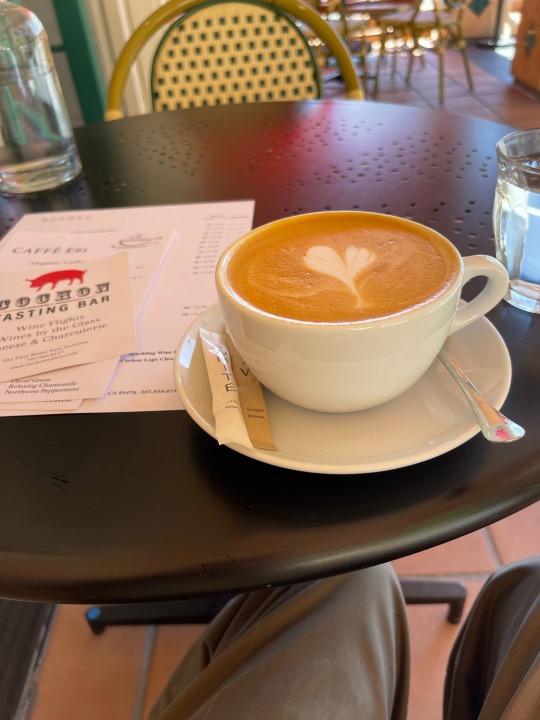
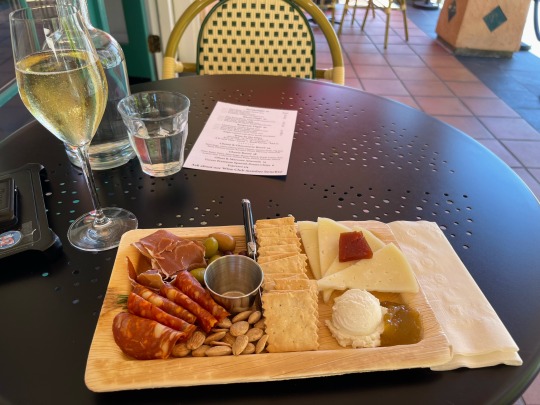


0 notes
Text
Unveiling the World of White Wines in Singapore: A Paradise for Wine Enthusiasts
Singapore, a vibrant metropolis known for its dazzling skyline and culinary scene, also boasts a thriving wine culture. While red wines often take center stage, white wines offer a refreshing and versatile alternative, perfectly suited to the tropical climate. This article delves into the exciting world of white wines in Singapore, exploring popular varieties, local favorites, and tips for navigating the vast selection available.
A Global Journey in Your Glass: Popular White Wine Varieties
Singapore's wine scene reflects its cosmopolitan nature, offering an extensive selection of white wines from across the globe. Here's a glimpse into some of the most popular varieties:
Sauvignon Blanc: A perennial favorite, Sauvignon Blanc is known for its crisp acidity, vibrant citrus flavors (think grapefruit, lime), and refreshing herbal notes. Wines from New Zealand's Marlborough region are particularly celebrated for their distinctive grassy and gooseberry characteristics. Explore options from France's Loire Valley, South Africa's Stellenbosch region, or Chile's Casablanca Valley for a wider range of flavor profiles.
Chardonnay: This versatile grape variety can produce a spectrum of wines, from light and unoaked with hints of apple and pear to rich and buttery styles aged in oak barrels, developing notes of vanilla and toast. California, Burgundy in France, and Australia are renowned for their Chardonnay offerings.
Pinot Gris (Pinot Grigio): Often enjoyed for its light-bodied character, dry finish, and subtle flavors of pear, honeydew melon, and citrus. Italian Pinot Grigio tends to be lighter and crisper, while French Pinot Gris may offer richer body and texture.
Riesling: A fascinating grape known for its ability to produce wines ranging from bone-dry to lusciously sweet. German Rieslings showcase a beautiful interplay of sweetness and acidity, often with notes of minerality, honey, and stone fruit. Explore options from the Rheingau, Mosel, and Pfalz regions for diverse styles.
Other White Wine Varieties: The world of wine white extends far beyond these popular choices. Consider venturing into the floral and aromatic world of Gewurztraminer, the refreshing minerality of Gruner Veltliner from Austria, or the tropical fruit notes of Viognier.
Local Gems: Exploring Singaporean Favorites
While Singapore may not have its own vineyards, its strategic location and free trade policies have made it a hub for wine distribution and appreciation. Local wine retailers and restaurants curate exciting selections, featuring established and emerging regions alongside well-known classics. Here are some Singaporean favorites to keep an eye out for:
New World Sauvignon Blancs: New Zealand Sauvignons Blancs are particularly popular in Singapore, with brands like Cloudy Bay, Marlborough Sauvignon Blanc, and Villa Maria Sauvignon Blanc consistently gracing wine lists.
Australian Chardonnay: Australian Chardonnays offer a good balance between fruitiness and oak influence, making them crowd-pleasers. Look for labels like Penfolds, Yalumba, and Wolf Blass.
Unoaked Chardonnays: A growing trend in Singapore is the appreciation for unoaked Chardonnays, which highlight the pure fruit character of the grape. Explore offerings from Argentina or Chile for vibrant expressions.
Beyond the Classics: Pairing White Wines with Singaporean Cuisine
The beauty of white wines lies in their versatility when paired with food. Here are some suggestions for enjoying white wines with Singapore's diverse cuisine:
Spicy Dishes: The high acidity of Sauvignon Blanc cuts through the heat of spicy dishes like Sichuan Kung Pao Chicken or Thai curries.
Seafood: Light-bodied white wines like Pinot Grigio or unoaked Chardonnay complement the delicate flavors of steamed fish or shellfish dishes.
Dim Sum: Aromatic white wines like Gewurztraminer or Riesling can stand up to the rich flavors and textures of dim sum.
Nyonya Cuisine: The sweet and sour notes of Nyonya dishes find harmony with the off-dry styles of Riesling or Gewurztraminer.
Navigating the Wine List: Tips for Choosing a White Wine in Singapore
With such a vast array of options, choosing a white wine can feel daunting. Here are some helpful tips:
Consider the Occasion: Is it a casual gathering or a special celebration? Lighter styles like Sauvignon Blanc or Pinot Grigio might suit a casual setting, while a richer Chardonnay or Riesling could elevate a special occasion.
Food Pairing: Think about the food you'll be enjoying and choose a wine that will complement the flavors.
Grape Variety Preference: Do you have a favorite grape variety? Explore different regions and styles within that variety to discover new favorites.
Budget: Wine prices can vary
0 notes
Text
Laura Michael Wines: The Pioneering Couple-Duo Behind Calistoga’s Boutique Winery
Wine! Oh, that brings in many memories, doesn’t it!? A glass of wine at weddings, birthdays, meet-ups, anniversaries, or even a relaxing glass at the end of a long day.

Regardless, it does taste good, now that’s for sure!
The cultivation of vineyards and wineries for the consumption of wine has become a part of people’s culture, meals, and symbols. The moderate consumption of wine can be quite beneficial health-wise as it is high in antioxidants and is an anti-inflammatory.
But if wine is consumed in amounts that are anywhere above moderate levels, and the consumption of it is regularly in an unhealthy way, well, we know first-hand or would’ve witnessed its after-effects and consequences of its effect on people.
Be it severe intoxication and physical harm to one’s health and lifestyle, addictions to unhealthy consumption of wine can lead to alcoholism and the destruction of families and friends who are present around the addicted person. As anything in excess is always bad, practicing moderate, responsible, and mindful consumption of wine is better.
Winemaking has an advantage on the economy of a place, In the conservation of the land, creating and providing job opportunities for people to work in the vineyards and learn the art of winemaking, it can be a tourist attraction area which would increase revenue and profits, it reduces the carbon footprint if wine is made locally, and it respects and celebrates culture and the quality of life.
The process of winemaking consists of many steps that are carefully and meticulously followed. Experts, professionals, and people dedicated to learning the art of winemaking need to know the entire book before even implementing any business in wineries.
Wine is the final by-product that can wake the taste buds immediately from planting to growing grapes, from harvesting to crushing, from juicing to fermenting, and lastly from post-fermenting to aging the celestial liquid.
This liquid can be stored in drums and bottles, the longer they are stored – the sweeter they taste. Hence this is why special wines that are brought out for serving in hotels and restaurants or as a wine collector, wines that have been stored from many years ago always taste sweeter and are more precious.
Therefore in this article, we shall be exploring the story behind a determined woman entrepreneur – Laura Swanton who started her journey in winemaking and who was soon supported by her husband – Michael Swanton, in their ‘wine-full’ journey together in establishing a successful vineyard estate business – Laura Michael Wines, in the Napa Valley region of North California, The United States of America.
Laura Zahtila Swanton – Founder and Proprietor:
The founder, owner, and proprietor of Laura Michael Wines is Laura Zahtila Swanton.
The story of Laura Zahtila Swanton starts with her working at Cisco Systems as a Sales Specialist. While still working at the company, Laura purchased a winery estate in the year 1999 from a family, in Calistoga, Napa Valley Region of North California, USA.
The vineyard of the boutique winery was already functional and operating since the year 1980. To fully commit herself to the winery, Laura Zahtila Swanton was determined to learn and educate herself on the hows, whys, knows, and everything else there is that revolve around planting, growing, harvesting, winemaking, processing, and marketing.
For insights and reads, visit The Business Magnate for more interesting content.
The founder showed her full passion and interest in the Calistoga Winery by executing certain renovations to improve the winery’s crush pads for increased functionality, and its fermentation tanks to have insulations, incorporating LED lighting, and thereby invested her time, money, and effort in several other required and needful types and pieces of equipment that would launch her winemaking business right away.
Laura Zahtila Swanton married now Vice President and Vineyard Manager – Michael Swanton, and the two wine pioneers continued their journey to success together.
Laura Michael Wines:
The Calistoga winery in the Napa Valley region is famous for its wineries and vineyards that are present in the city. Purchased by Laura Zahtila Swanton in 1999 from a family who had previously owned the winery estate, the founder soon started her business after a few years of studying and renovating certain areas and pieces of equipment in the winery.
The business produces and markets small batches of wine, and they are known for their famous Cabernet Sauvignon and Zinfandel variations among many others. Laura Michael Wines produces 3 categories of their wines, namely – White Wines, Red Wines, and Dessert Wines.
In the White Wines category, the winery produces – Napa Valley Chardonnay and Michael’s Muse Dry Rosè of Zinfandel.
In the Red Wines category, the winery produces – Oat Hill Estate Zinfandel, Russian River Pinot Noir, Rutherford Cabernet Sauvignon, Calistoga Cabernet Sauvignon “Barlow Vineyards”, and Bentley Cabernet Sauvignon Rutherford. In the Dessert Wines category, the winery produces – Laura’s Theme Dessert Wine (Non-Vintage).
Having had good experience and knowledge with technology and its product applications from working at Cisco Systems before her winemaking venture, Laura Zahtila Swanton had the necessary information and know-how in the marketing area of the winery.
The winegrowing philosophy of Laura Michael Wines – “To emphasize whatever the grapes give us – consistency is key….”
In the year 2006, Michael Swanton joined Laura Zahtila Swanton at Laura Michael Wines as a business partner for his valuable knowledge and expertise in Engineering and Power Generation. After a few years, the duo got married and the boutique winery business was named – Laura Michael Wines after the wine-making couple.
At Laura Michael Wines, the couple-duo has taken to marketing small-batch wines and has since successfully managed to handle the consequences of the crashing market during the COVID-19 Pandemic.
“Our goal is a wine that will age, but with balance.” – Laura Zahtila Swanton.
With the growing concerns about the environment, biodiversity, and ecosystem, the couple – Laura Zahtila Swanton and Michael Swanton at Laura Michael Wines have adopted and implemented strategies in their walk toward a sustainable future. For its efforts and go-green initiatives since 2015, Napa Valley has certified Laura Michael Wines as a “Napa Green Winery”. Be it saving on water consumption, reducing waste production by composting and recycling the waste produced, saving energy by LED lighting, and decreasing carbon footprint by insulating their winery’s fermentation tanks.
Visit More : https://thebusinessmagnate.com/laura-michael-wines-the-pioneering-couple-duo-behind-calistogas-boutique-winery/
0 notes
Text
Where Does Your Food Come From? Part 2-Backyard Gardens
Backyard gardens have gone from a necessity to a hobby and now are maligned by certain people we will call, “globalists.” Claims that backyard gardening has a carbon footprint 5 times greater than commercial growing have been published along with a lot of other rubbish, as if the amount of carbon you make growing plants makes a difference in the global climate. The fact is that plants need CO2 to produce oxygen and to grow. In any case, we need to eat and during WWII, Great Britain would have gone down and during the Great Depression, there would have been more starvation without backyard gardens. Today, we are faced with a similar situation where much of the food we can buy is not good for us and is getting less and less affordable. Whenever times are hard, gardens become increasingly important by providing cheap, nutritious sources of food.
I grew up with gardens. I even had one at an apartment complex where I was living. People laughed at my little garden- a container of tomatoes, two of peppers, and a bucket of potatoes, until the tomatoes came on. Home grown tomatoes outshine store bought any day. When I started my own family, I also started a small farm on 1/3 of an acre. It was already planted with oranges, plums, cherries, peaches, grapes and artichoke and asparagus beds. I added a spectacular variety of vegetables, a couple of ducks to eat the slugs and snails and a little coup of chickens. Our grocery bill was the lowest on the block.
Now I understand that this would not be possible anywhere. It was in California, in the Central Valley where the growing season is long. However, no matter where you are, you can grow something. Fruit and nut trees are seasonal, but they produce each year and only need minimal care. The same goes for many berries. Asparagus and artichokes will also produce as long as the beds are taken care of, and the winter temperatures are not super cold. As far as the super cold is concerned, I read about one family that lived in a very cold, snowy area and raised winter crops in a greenhouse heated by rabbits. That’s a two for! The point is that where there is a will there is a way.
If you’ve read some of my other articles on food, you already know there are plenty of reasons to have your own garden. The biggest reason is that it’s your garden and you are in control of what methods to use, and what chemicals, if any. The second best reason is that the food tastes better and is more nutritious than that grown in large monocrop fields. Then there is the time you spend outside, collecting vitamin D from the sun and getting a little exercise. There is a food shortage already happening. With the crop failures, the movement to stop meat from being produced, farmland being taken out of production, and other problems, it is getting increasingly difficult to be able to afford nutritious food. It may at some point get difficult to find at all.
In light of the above, having whatever garden one has the room for, or can make the room for, is going to be important. I know many are not able to have gardens because of space and other reasons. In that case, community gardens, farmers’ markets, or just getting to know a farmer through doing business with them would be a plus. As for those who have the space but claim to have black thumbs- My oldest daughter claimed to have a black thumb yet when she took over management of a small 7-acre farm, she not only raised many animals, but her vegetable garden was an unqualified success. She used the internet, other gardeners, and books on gardening as her guides to achieve this success.
A wealth of information exists on different kinds of gardening, The internet, of course, has a ton of information. People around you can also be a source of information that is more local and can give you tips based on the locality. Rodale put out a series of gardening books with some great information as have a number of other publishers. Local groups organized around the planted seed can be contacted as well as your state agriculture organization.
I understand that some of you live in the city where space is at a premium. You might not have a backyard to plant in. Container, vertical, roof top, and hydroponic gardens are an answer to this problem. The point is to start thinking about your food now. Just stocking up will only be a temporary solution. Fresh food needs to be added to the mix both for nutrition and to make the preserved supplies last. My advice for anyone able to do it is to bury some seeds.
If there is a subject you would like to hear about food, food production or even stories about my experiences in the food industry, and I have some great ones, drop me a line by accessing my contact page on my site: https://irawhite.com/contact/
0 notes
Text

Napa Valley is renowned for its rich history in winemaking. Considered to be the premier wine region in the United States, this 30-mile-long valley boasts hundreds of wineries.
Its unique climate and topography provide the perfect conditions for growing grapes, with warm days, cool nights, a combination of coastal fog, ocean breeze, and hot summers. This creates a longer growing season which allows for more complex flavors to develop in the grapes.
1 note
·
View note
Text
Exploring Yountville’s Terroir
In the heart of Napa Valley, Yountville has a distinguished terroir that sets its wines apart. The terroir here is relatively new compared to wine regions around the world–although it's still 150 million years old!
What was once ocean floor was pushed upwards, and valleys formed. One of them was the Napa Valley, where Yountville, California wineries enjoy incredible soil diversity and unique microclimates.
Yountville’s unique microclimate
Yountville’s southerly location brings cooling breezes and morning fog from the San Pablo Bay right to the grapevines. The grapes stay cool in the afternoons when the sun is most intense.
Yountville experiences significant temperature swings, called diurnals, from day to night. During the day, grapes ripen in the sunshine, and then night temperatures cool them down, allowing them to retain their acidity. This balancing act in the vineyard allows us to create wines with depth and age-ability.
Yountville, California wineries’ soil diversity
Soil type greatly affects how a grapevine grows, how much water and nutrients it can get, and the quality of grapes it produces.
Yountville soils are sedimentary in origin and are made up of gravelly silt loam and alluvial soils and rock. Loam keeps the soil poor enough so that the grapevines have to struggle. This sounds bad, but it’s actually a good thing–grapevines need a little stress to produce quality wine grapes with concentrated flavor compounds.
The gravelly alluvial soil and rocks provide excellent drainage for the grapevines, forcing their roots to dig deeper into the earth in search of nutrients. This means longevity for the vineyard, and it also means complex wines!
Signature grapes of Yountville
Some of the most famous grapes in the world are grown here, including Cornerstone Cellars, making distinctive terroir-focused wines. Here are just some of what Yountville, California wineries have to offer:
Cabernet Sauvignon makes structured wines with complexity and the ability to age for decades
Merlot can make fresh, fruity wines with high acidity or deep, complex wines with bold dark fruit flavors
Cabernet Franc makes wines with dark cherry and currant, as well as herbaceous notes like green bell pepper
Chardonnay is an incredibly versatile grape that can make crisp, mineral-driven wines with citrus fruit, or full-bodied, creamy wines with tropical and stone fruit.
Sauvignon Blanc is an aromatic white grape with notes of grapefruit, passionfruit, and flowers
Local winemaking traditions
Here in Yountville, our winemaking tradition is built on a desire to showcase terroir—what each plot of land has to offer our grapes. Our winemakers at Cornerstone Cellars often create varietal wines, also known as single-vineyard bottlings. Rather than blending one grape from several vineyards, winemakers will choose to make wine from the fruit of one single plot of land. This is how we practice the art of storytelling.
That tradition and history also includes our very own tasting salon! Dating back nearly 150 years as the oldest standing structure in the Town of Yountville, our building was the original train depot for this part of the Napa Valley. We are honored to keep our own little part of history in Yountville alive and well.
0 notes
Text
Experience the Beautiful of Napa Valley with an Amazing Wine Tour
Situated in the scenic wine area of the state of California, Napa Valley is known for its world-class vineyards, beautiful surroundings, and glamorous experiences. Thanks to its famous for producing high-quality wines, wine lovers go from all over the world to Napa Valley to tour its vineyards and enjoy its delicious offers. A Napa Valley wine tour offers the ideal balance of knowledge, adventure, and indulgence, making it an amazing trip through this famous area. We'll cover all you need to know in our extensive guide to organize and enjoy a memorable wine tour in Napa Valley.

The Napa Valley's Beauty
Many different grape varietals are produced by the distinct terroir of Napa Valley, which is widely recognized. The valley's soil types and conditions are perfect for producing outstanding wines, ranging from the bold Cabernet Sauvignon to the graceful Chardonnay. One of the main factors contributing to Napa Valley's rise to prominence as a wine destination is its wide diversity.
Napa Valley is well known for its breathtaking beauty in addition to its wines. A beautiful setting for any visit is created by rolling hills covered with well-kept vineyards, little wineries with rustic architecture, and attractive backroads. A wine tour in Napa Valley is an incredibly rewarding experience because of the area's dedication to sustainable farming methods and emphasis on quality rather than quantity.
Organizing Your Wine Tour of Napa Valley
Selecting the Appropriate Time to Go
Napa Valley is a throughout-the-year travel location, with distinct charms to be found in every season. Growing the vines and flowering mustard flowers create a vivid and colorful scene during spring, which lasts from March to May. The summer months of June through August are popular travel times because of the pleasant weather and verdant vineyards. The best time to visit is during harvest season, which runs from August to October when wineries are hopping and you can see the winemaking process up close. Winter (November to February) provides the chance to enjoy cozy tastings by the fire and a more sedate, private experience with fewer visitors.
Choosing the Vineyards
There are more than hundreds of wineries in Napa Valley, each with its special features and ambiance. Think about your interests and preferences while organizing your wine tour. Do you like more contemporary vineyards with cutting-edge technology, or are you drawn to historic estates with rich historical backgrounds?
Organizing a Tour
A Napa Valley wine tour can be enjoyed in a variety of ways, based on your interests and affordability. Private tours are a well-liked option because they are informative and practical. Services such as Wine Country Limousines offer luxurious travel and accurate tour guides who may tailor your experience according to your tastes. Additionally, there are group trips that provide a more social experience with other like-minded wine experts.
If you desire a more customized experience, think about scheduling private excursions. You can have an exclusive and intimate experience by taking advantage of the private tastings and tours that many wineries provide. Another alternative that allows you to explore at your speed is self-guided tours. A different view of the valley can be had by hiring a car or a bike, but make sure to schedule your route and tasting workouts well ahead.
The Experience of Wine Exploring
Recognizing Proper Wine Tasting Methods
In Napa Valley, wine tasting is an art form, and you can improve your experience by being aware of a few essential manners. Instead of heating the wine with your hand, start by holding the glass by the base. Examine the color and clarity of the wine, then tilt the glass slightly to unleash the scents. Before you take a tiny drink, take a moment to absorb the aroma with a deep sniff. Taste the wine and take note of its flavors and texture as it coats your palate. Spitting out the wine after sampling is quite acceptable, particularly if you expect to visit other wineries.
Considering Various Taste Moments
Wineries in Napa Valley provide a range of tasting options, from informal bar tastings to formal restaurant tastings. A few wineries offer informative tours that explore the entire winemaking process, from the vineyard to the bottle. You might be able to take a tour of the barrel-aging cellars, fermenting facilities, and vineyards to learn more about what makes each wine special.
Napa Valley wine tours include meal and beverage pairings, which is another interest. To produce culinary arts combinations that complement the flavors of their wines, several wineries partner with well-known restaurants. These experiences, which highlight the region's culinary prowess, can vary from straightforward cheese and savory platters to multi-course dinners.
Improving Your Understanding
Participating in a Napa Valley wine tour and learning from professionals is one of its delights. Wine experts and winemakers are enthusiastic about what they do and want to impart their expertise. Never be afraid to strike up a discussion or ask questions regarding the wines you're tasting. Gaining knowledge about various grape varietals, winemaking methods, and the impact of the environment can enhance your admiration for the local wines and their place of production.

Exploring the Wineries: A Tour of Napa Valley
Even though wine is the main draw, Napa Valley has plenty of other things to do and see while you're there.
Specialty Food Service
There are many fine-eating substitutes in Napa Valley to go along with your wine tour, making it a food lover's dream come true. The food culture in the area is as varied as its wines, including little farm-to-table eating places to Michelin-starred restaurants. Make preparations well in advance, particularly during certain times of the year.
Adventures on Hot Air Balloons
A hot air balloon ride over Napa Valley offers a unique experience. Midnight wineries are a peaceful sight, and you can enjoy spectacular vistas while floating gently over them. Pre-flight drinks and sparkling breakfasts after the trip are included in many packages that companies provide.
Relaxation and Spa facility
Visit one of the opulent spas in Napa Valley for some pampering and relaxation after a day of wine tasting. Numerous spa centers and resorts provide a variety of therapies, such as cleaning the earth baths and massages with grape seed oil. Calm down and restore yourself to the valley's peaceful environment.
Outside Events
The breathtaking scenery of Napa Valley entices exploration outside. Beautiful views and an opportunity to get in touch with nature may be found along the hiking and biking routes that wind through the hills and wineries. There are also rowing and boating opportunities on the Napa River.
Conclusion
A Napa Valley wine tour is an experience that takes you inside a world of rich history, delectable flavors, and unmatched beauty rather than merely a drive past vineyards. Napa Valley provides a thrilling and informative experience for all levels of wine supporters, from seasoned professionals to aspiring beginners. This famous region has much to offer everyone, from fine dining and wine tastings to outdoor activities and wellness vacations. Experience the charm that lies in this captivating region of California's wine country by scheduling your Napa Valley wine tour today.
#napa valley wine tour#napa wine valley tours#wine tours in the napa valley#napa wine tours#wine tours of napa valley
0 notes
Text










Napa, CA (No. 2)
Wine Country is a region of California, in the northern San Francisco Bay Area, known worldwide as a premier wine-growing region. The region is famed for its wineries, its cuisine, Michelin star restaurants, boutique hotels, luxury resorts, historic architecture, and culture. Viticulture and wine-making have been practiced in the region since the Spanish missionaries from Mission San Francisco Solano established the first vineyards in 1812.
There are over 1700 wineries in the North Bay, (according to Alcoholic Beverage Control of California), mostly located in the area's valleys, including Napa Valley in Napa County, and the Sonoma Valley, Alexander Valley, Dry Creek Valley, Bennett Valley, and Russian River Valley in Sonoma County. Wine grapes are also grown at higher elevations, such as Atlas Peak and Mount Veeder AVAs. Cities and towns associated with the Wine Country include SantaRosa, Healdsburg, Sonoma, Kenwood, Petaluma, Sebastopol, Guerneville, Windsor, Geyserville, and Cloverdale in Sonoma County; Napa, Yountville, Rutherford, St. Helena and Calistoga in Napa County; and Hopland and Ukiah in Mendocino County. Wine is also an important part of the economy in nearby Lake and Solano Counties.
Source: Wikipedia
#Napa#Napa Valley#don't drink and drive#travel#original photography#vacation#tourist attraction#landmark#cityscape#landscape#Napa County#wine country#Bay Area#summer 2022#USA#California#West Coast#flora#sunset#palm tree#hills#silhouette
1 note
·
View note
Text
Explore Napa Valley with Got Luxury Ride. How to visit Napa Valley from San Francisco?
If you want to see the best of what Napa Valley has to offer, look no further than Got Luxury Ride. We’re your luxury car service with the most luxurious vehicles and attentive service. Whether you want to visit one of our many wineries or just enjoy the scenery on our scenic drives, we can make it happen!
With Got Luxury Ride, you can visit Napa Valley and Sonoma Valley. Napa Valley is one of the best places to visit in California. If you want to explore this region, Got Luxury Ride can assist you.
If you’re planning a trip to Napa Valley, there are many different ways that we can get you there and back safely. We have an experienced driver who will take care of everything so that everyone has an enjoyable time while visiting this incredible area!
We also offer several packages that include some great amenities such as air conditioning, a DVD player, and more! You’ll be able to relax during those long drives by watching movies or listening to music with your headphones!
Limos are a popular way to take in Napa Valley’s beautiful scenery. When you’re travelling with friends or family, it can be difficult to make plans and agree on what to do. With a Limo Service in Napa Valley, however, you can all get together and enjoy the trip without having to worry about driving or parking. Limousine services are more convenient and comfortable than driving yourself in Napa Valley!
A day full of activities in Napa Valley Visit the wineries. There are many wineries in Napa Valley, and they offer wine tastings to sample some of the best wines in California. You can also visit their gift shop or even have lunch at their restaurant if you want to eat something other than wine! Each winery offers different experiences, so make sure to check them all out! Visit the vineyards. Vineyards offer a great way to experience nature by walking through their fields, seeing where grapes grow up close and personal (not just from afar), learning about how this important part of agriculture works with humans worldwide, and even getting some exercise while doing so! They may even have tours available for those who aren’t familiar with what goes into making wine, grapes, etc. You can visit the vineyards and wineries yourself, but it’s just as fun to do it with a limo service. You can visit the vineyards and wineries yourself, but it’s just as fun to do it with a limo service. A limo service is more convenient and comfortable than driving yourself in Napa Valley. You can enjoy your time in Napa Valley without worrying about driving or parking, which saves you money and allows you to focus on enjoying your trip!
Limousine services are always more convenient and comfortable than driving yourself in Napa Valley. You can enjoy your time in Napa Valley without worrying about driving or parking, which saves you money and allows you to focus on enjoying your trip!
Discover scenic wine country in Napa Valley. Napa Valley is one of the most famous wine regions in California, and it’s easy to see why. With over 300 wineries, there are plenty of reasons to visit here.
Sonoma Valley is another great place to visit if you’re looking for a smaller town with more character than Napa Valley. Sonoma County has some amazing wineries that are worth checking out as well!
If you’re looking for a great way to experience Napa Valley, Sonoma Valley, and the surrounding area, then hiring a private driver is the best way to go. We’ve got some great options available that will make sure you get the most out of your time spent touring this region!
From San Francisco, how can I get to Napa Valley? We can take you to all the best places in Napa Valley. We have a variety of luxury car services to San Francisco airport for you to choose from, and our prices are reasonable and affordable!
So you’re in San Francisco, and you want to visit Napa Valley. What’s the best way to get there?
We’ve got you covered! There are plenty of ways to get from San Francisco to Napa, but we recommend taking the Got Luxury Ride.
You’ll be able to see some beautiful scenery as you travel between San Francisco and Napa Valley, which is why we recommend taking this route over driving or flying.
Conclusion The best way to explore Napa Valley is with a luxury car service. With our reliable transportation and professional chauffeurs, you can visit all the wineries in Napa Valley without worrying about driving your car. Got Luxury Ride also provides airport transfers and VIP transportation for special events like weddings, corporate events, and simply getting around town!
1 note
·
View note
Text
Collecting California Wine - Aubert Winery

When it comes to the world of wine, California has established itself as a premier destination for connoisseurs and collectors, in part due to a rich winemaking history dating back to the 18th century. Currently, California is synonymous with high-quality winemakers that produce some of the most desirable bottles internationally. Despite the diverse range of wines produced in the region, Napa Valley continues to hold a dominant position in the realm of premium wine, with producers such as Aubert Winery.
Established by Mark Aubert, Aubert Winery has earned a reputation for crafting some of the world's most exquisite Chardonnays and Pinot Noirs. The small-scale winery sources its grapes from carefully selected cool-climate vineyards throughout Napa Valley, including some of the area's most desired growing areas. The result is luxurious Chardonnay wines with layers of complexity and a long-lasting finish.
Auberts Pinot Noirs are also popular with collectors. They are described as elegant and blend well with the natural characteristics of the grape and the unique soil of Napa Valley. Aubert's production is deliberately limited, ensuring that each bottle receives meticulous attention and allowing for an artisanal touch that permeates every aspect of the wine. For this reason, its wines have earned a loyal following among collectors, and their scarcity and consistently high ratings have made them highly sought-after in the wine market.
0 notes